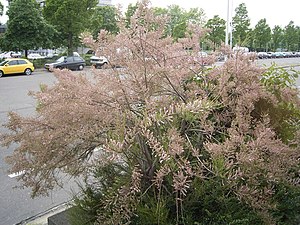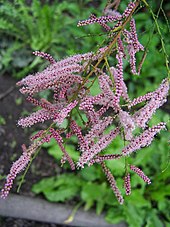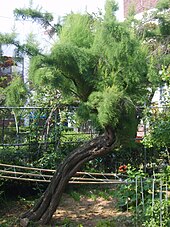Tamarisk
| Tamarisk | ||||||||||||
|---|---|---|---|---|---|---|---|---|---|---|---|---|

French tamarisk ( Tamarix gallica ) |
||||||||||||
| Systematics | ||||||||||||
|
||||||||||||
| Scientific name | ||||||||||||
| Tamarix | ||||||||||||
| L. |
The tamarisk ( Tamarix ) are a genus of plants from the tamarisk family (Tamaricaceae). It includes about 55 to 90 species.
description

Appearance and leaves
Tamarix species grow as small, well-branched, xeromorphic , often deciduous trees and shrubs that usually reach heights of 1 to 10, rarely up to 18 meters. They are deep-rooted plants. As long as they are young, the narrow twigs have a smooth bark that is differently colored depending on the species, often reddish-brown to blackish-brown . As they age, the bark becomes brownish-purple and furrowed-rough.
The alternate leaves densely covering the branches are small, scaly, hairless to tomentose, often gray-green and 0.5 to 7 millimeters long. The leaves are able to secrete salt with point-shaped glands.
Inflorescences and flowers
The flowering period usually extends from March to September. At the end of young or older twigs are simple or branched, racemose or paniculate inflorescences , which are 1 to 15 centimeters long, depending on the species. The four- or five-fold flowers are mostly hermaphroditic; if they are unisex, then they are dioecious, separate-sex plants ( diocesan ). Usually each flower stands over a bract , rarely over two or more bracts, which depending on the species can be very different in shape and leaf margin. The more or less the same four or five sepals are only fused at their base and are very different in shape and leaf edge depending on the species. The four or five free petals are white to pink to purple in color. There are usually four to ten, rarely up to twelve stamens . The mostly three to four, rarely five or two free pistils end in head-shaped scars that are two to three times shorter than the ovary . There is a discus.
Fruits and seeds
The small capsule fruits open with three compartments from above towards the base and contain many seeds. The small, about 1 millimeter large seeds have small tufts of hair through which they are spread by the wind.
ecology
Few types of tamarisk are planted partly as wind protection on coasts, but also as ornamental plants. They are resistant to salty soils and also tolerate alkaline soil conditions. The germination capacity is still given at a salinity of 30 to 40 mS * cm-1, which roughly corresponds to an osmotic potential of 1 to 2 MPa. The galls are rich in tannic acids . When a species of scale insect injures the bark, the manna tamarisk ( Tamarix nilotica ) produces a substance called manna .
The spread takes place both via vegetative propagation with offshoots and via sexual reproduction via seeds that are spread by the wind.
Tamarisks were also introduced to the USA at the beginning of the 18th century and were planted there in the 1930s by the Civilian Conservation Corps as windbreaks in dry areas. As a result, tamarisks have spread throughout the southwestern United States and have been intensely controlled as an invasive species since the turn of the millennium. As a reference area for the success of the control z. B. the area on the San Miguel River in Colorado . The corresponding work was completed there in December 2008.
Occurrence
The distribution area of the genus Tamarix includes the Mediterranean region , Asia to northern China and the arid regions in northern Africa . The main occurrences are in saline areas of deserts and semi-deserts, there are also occurrences in steppes or in the mountains along rivers or springs. In Pakistan , there are 26 species and in China are 18 kinds ago, seven of which occur only there.




Systematics
The genus Tamarix was published by Carl von Linné in Species Plantarum in 1753 . A synonym for Tamarix L. is Trichaurus Arn.
In the genus Tamarix there are 55 to 90 species (selection):
- Summer tamarisk or African tamarisk ( Tamarix africana Poir. ): It is native to southern Europe ( Spain , Portugal , France , Italy ), north Africa ( Morocco , Algeria , Tunisia ) and the Canary Islands .
- Tamarix alii Qaiser : It only occurs in the Pakistani province of Sind .
- Tamarix androssowii Litw. : It is common in China , Mongolia and Central Asia.
- Leafless tamarisk ( Tamarix aphylla (L.) H.Karst. , Syn .: Tamarix articulata Vahl , Thuja aphylla L. ): It is widespread in Africa , West Asia , Arabia and South Asia.
- Tamarix arceuthoides Bunge : It is widespread in West and Central Asia, and in the Gobi Desert in the Chinese provinces of Gansu and Xinjiang and in Mongolia.
- Tamarix austromongolica Nakai : It occurs in China.
- Tamarix baluchistanica Qaiser : It occurs only near the Pakistani city of Quetta .
- Tamarix boveana Bunge : It occurs in the Canary Islands, Morocco, Algeria, Spain, the Balearic Islands, Tunisia and Libya.
- Canary Tamarisk ( Tamarix canariensis Willd. ): It occurs in the Canary Islands.
- Tamarix chinensis Lour . (Syn .: Tamarix juniperina Bunge ): It is native to China and Korea .
- Dalmatian tamarisk ( Tamarix dalmatica B.R. Baum ): It occurs in Italy, Sicily, Sardinia, Corsica, Croatia and on the Balkan Peninsula.
- Tamarix dioica Roxb. ex Roth : It is common in Afghanistan , Iran , India , Pakistan, Nepal , Bhutan , Bangladesh and Myanmar .
- Tamarix elongata Ledeb. : It is common in China, Kazakhstan , Mongolia, Russia , Turkmenistan and Uzbekistan .
- Tamarix ericoides Rottl. et Willd. : It is common in India, Pakistan, Sri Lanka and Bangladesh.
- French tamarisk ( Tamarix gallica L. ): It is native to France , Italy and Spain , but is naturalized in Great Britain and the USA .
- Tamarix gansuensis H.Z.Zhang ex PYZhang & MTLiu : It occurs only in the Chinese provinces of Gansu, Nei Mongol , Qinghai and Xinjiang
- Tamarix gracilis Willd. : It is native to Asia and the European part of Russia.
-
Tamarix hispida Willd. : It is native to Asia and the European part of Russia; there are several varieties:
- Tamarix hispida Willd. var. hispida
- Tamarix hispida var. Karelinii (Bunge) BR tree (Syn .: Tamarix karelinii Bunge ): It occurs in Asia.
- Tamarix indica Willd. : It occurs in Afghanistan, Pakistan, India, Sri Lanka and Bangladesh.
- Tamarix jintaensis P.Y.Zhang & MTLiu : It occurs only in the Chinese province of Gansu.
- Tamarix jordanis Boiss. : It occurs in Syria , Lebanon , Israel and Jordan .
- Tamarix kermanensis tree : It occurs only in southwest Iran and Pakistan.
- Tamarix korolkowii Regel & Schmalh. : It is common in Asia ( Iraq , Iran, Afghanistan, Pakistan, Kazakhstan, Uzbekistan and Tajikistan ).
- Tamarix kotschyi Bunge : It occurs in Afghanistan, Pakistan, Iran and Russia.
- Tamarix laxa Willd. (Syn .: Tamarix pallasii Desv. ): It is native to Asia and the European part of Russia.
- Tamarix leptostachya Bunge : It is common in China, Mongolia and Central Asia.
- Tamarix mascatensis Bunge : It occurs in Arabia, Somalia, Socotra, Iran, Pakistan and the Caucasus.
- Manna tamarisk ( Tamarix nilotica (Ehrenb.) Bunge , Syn .: Tamarix mannifera (Ehrenb.) Bunge ): It is widespread in Africa, Arabia and Western Asia.
- Tamarix pakistanica Qaiser ; it is based in Pakistan.
- Tamarix palaestina Bertol. : It is native to Israel and Jordan.
- Small-flowered tamarisk or spring tamarisk ( Tamarix parviflora DC. ): It is native to southeast Europe , Turkey and Israel.
- Tamarix passerinoides Del. ex Desv.
- Heidetamariske even Caspian tamarisk or Erika shrub called ( Tamarix ramosissima Ledeb. , Syn .: Tamarix pentandra Pall. , Tamarix pallasii var. Brachystachys Bunge , Tamarix odessana Steven ex Bunge ): it is in Eastern Europe spread and Asia.
- Tamarix sachensis P.Y.Zhang & MTLiu : It occurs on sand dunes in Xinjiang .
- Tamarix salina Dyer : It is from Pakistan.
- Tamarix sarenensis Qaiser : It is native to Pakistan.
- Tamarix smyrnensis Bunge (Syn .: Tamarix Hohenackeri Bunge ): It occurs in Eastern and Southeastern Europe as well as in Western and Central Asia.
- Tamarix stricta Boiss. : It isnative toIran and the Pakistani province of Balochistan .
- Tamarix sultanii Qaiser : It only occurs in the Pakistani province of Sindh .
- Tamarix szovitsiana Bunge : It occurs in Iran, Pakistan and Russia.
- Tamarix taklamakanensis M.T.Liu : It occurs in Gansu and Xinjiang .
- Tamarix tarimensis P.Y.Zhang & MTLiu : It only occurs in Xinjiang, China.
-
Tamarix tetragyna Ehrenb. : It is native to Egypt , Western Asia and Cyprus and occurs in the varieties:
- Tamarix tetragyna Ehrenb. var. tetragyna
- Tamarix tetragyna var. Meyeri (Boiss.) Boiss. (Syn .: Tamarix meyeri Boiss. ): It occurs in West and Central Asia.
- Four-male tamarisk ( Tamarix tetrandra Pall. Ex M.Bieb. ): It is widespread in Eastern and Southeastern Europe as well as in Western Asia.
Cultural history
Date palms and tamarisks grew in the Sumerian palace gardens , in the shade of which feasts were held. The “tamarisk tree” is mentioned in several places in the Bible (Genesis 21:33, 1.Sam 22.6, 1.Sam 31:13). In Egypt , it was believed that the soul of Osiris resided in a tamarisk, and tamarisks often surrounded tombs.
In the Koran, tamarisks are mentioned in connection with the Sabaeans in Sura 34 , 16.
swell
- Mohammad Qaiser: Flora of Pakistan 141: Tamaricaceae. Department of Botany, University of Karachi, Karachi 1982, Tamarix , pp. 2-42 (online at tropicos ). (Sections Description and Systematics)
- Cheng Liu Shu: Tamarix. In: Wu Zheng-yi, Peter H. Raven, Deyuan Hong (Eds.): Flora of China . tape 13 : Clusiaceae through Araliaceae . Science Press / Missouri Botanical Garden Press, Beijing / St. Louis 2007, ISBN 978-1-930723-59-7 , pp. 59–65 (English, online - PDF file; 230 kB ). (Sections Description and Systematics)
Web links
- Plant Conservation Alliance's Alien Plant Working Group: Factsheet: Saltcedar. 2005 ( online ). (engl.)
Individual evidence
- ↑ Walter Larcher : Ecophysiology of plants. Life, performance and stress management of plants in their environment (= UTB . Volume 8074 ). 6th revised edition. Eugen Ulmer, Stuttgart (Hohenheim) 2001, ISBN 3-8252-8074-8 , pp. 344 .
- ^ Scientists study control of invasive tree in western US.
- ^ New York Times: War With Riverbank Invader, Waged by Muscle and Munching . December 26, 2008
- ↑ Carl von Linné: Species Plantarum. Volume 1, Lars Salvius, Stockholm 1753, p. 270 ( digitized version ).
- ^ Tamarix in the Germplasm Resources Information Network (GRIN), USDA , ARS , National Genetic Resources Program. National Germplasm Resources Laboratory, Beltsville, Maryland. Retrieved December 13, 2013.
- ↑ a b c Cheng Liu Shu: Tamarix. In: Wu Zheng-yi, Peter H. Raven, Deyuan Hong (Eds.): Flora of China . tape 13 : Clusiaceae through Araliaceae . Science Press / Missouri Botanical Garden Press, Beijing / St. Louis 2007, ISBN 978-1-930723-59-7 , pp. 59–65 (English, online - PDF file; 230 kB ).
- ^ Mohammad Qaiser: Flora of Pakistan 141: Tamaricaceae. Department of Botany, University of Karachi, Karachi 1982, Tamarix , pp. 2-42 (online at tropicos ).
- ↑ a b c JL Villar (2017): Tamaricaceae. - In: Euro + Med Plantbase - the information resource for Euro-Mediterranean plant diversity. Datasheet Tamarix
- ^ Penelope Hobhouse: Gardening through the Ages. An illustrated history of plants and their influence on garden styles - from ancient Egypt to the present day. Simon & Schuster, New York a. a. 1992, ISBN 0-671-72887-3 .
- ^ Alix Wilkinson: Symbolism and Design in Ancient Egyptian Gardens. In: Garden History. Volume 22, No. 1, 1994, pp. 1-17 (here: p. 3; JSTOR 1586999 ).


